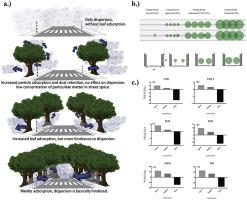当前位置:
X-MOL 学术
›
Atmos. Environ.
›
论文详情
Our official English website, www.x-mol.net, welcomes your feedback! (Note: you will need to create a separate account there.)
Canopy density effects on particulate matter attenuation coefficients in street canyons during summer in the Wuhan metropolitan area
Atmospheric Environment ( IF 5 ) Pub Date : 2020-11-01 , DOI: 10.1016/j.atmosenv.2020.117739 Xiaoshuang Wang , Mingjun Teng , Chunbo Huang , Zhixiang Zhou , Xiaoping Chen , Yang Xiang
Atmospheric Environment ( IF 5 ) Pub Date : 2020-11-01 , DOI: 10.1016/j.atmosenv.2020.117739 Xiaoshuang Wang , Mingjun Teng , Chunbo Huang , Zhixiang Zhou , Xiaoping Chen , Yang Xiang

|
Abstract Changes in vegetation traits influence the particulate pollution mitigating effects of trees in street canyons; however, it remains unclear whether tree canopy density (i.e. the proportion of the street floor covered by the vertical projection of the tree canopy) promotes or reduces this effect. A 12-day field experiment was conducted in four representative street canyons to examine the mitigating effects of street trees on particulate matter (PM) for PM1, PM2.5, PM4, PM7, PM10, and total suspended particles (TSP) among four canopy density treatments, including (1) open spaces and areas with (2) sparse (≤35%), (3) medium (35–70%) and (4) dense (≥70%) canopy densities. The results showed that canopy density is the dominant vegetation trait that affects PM dispersion, with peak decreases occurring at a canopy density of ∼30%. The particulate matter attenuation coefficient (PMAC) indicates the PM reduction capability of trees. The PMAC of each particle size class correlated negatively with canopy density and TSP (
中文翻译:

武汉都市圈夏季街道峡谷冠层密度对颗粒物衰减系数的影响
摘要 植被性状变化影响街道峡谷树木对颗粒物污染的减缓作用;然而,目前尚不清楚树冠密度(即树冠垂直投影所覆盖的街道地面的比例)是促进还是减少了这种影响。在四个具有代表性的街道峡谷进行了为期 12 天的实地试验,以研究行道树对四个树冠中 PM1、PM2.5、PM4、PM7、PM10 和总悬浮颗粒物 (TSP) 的颗粒物 (PM) 的缓解作用密度处理,包括 (1) 开放空间和具有 (2) 稀疏 (≤35%)、(3) 中等 (35–70%) 和 (4) 密集 (≥70%) 冠层密度的区域。结果表明,冠层密度是影响 PM 扩散的主要植被特征,在冠层密度约为 30% 时出现峰值下降。颗粒物衰减系数 (PMAC) 表示树木的 PM 减少能力。每个粒径等级的 PMAC 与冠层密度和 TSP 呈负相关(
更新日期:2020-11-01
中文翻译:

武汉都市圈夏季街道峡谷冠层密度对颗粒物衰减系数的影响
摘要 植被性状变化影响街道峡谷树木对颗粒物污染的减缓作用;然而,目前尚不清楚树冠密度(即树冠垂直投影所覆盖的街道地面的比例)是促进还是减少了这种影响。在四个具有代表性的街道峡谷进行了为期 12 天的实地试验,以研究行道树对四个树冠中 PM1、PM2.5、PM4、PM7、PM10 和总悬浮颗粒物 (TSP) 的颗粒物 (PM) 的缓解作用密度处理,包括 (1) 开放空间和具有 (2) 稀疏 (≤35%)、(3) 中等 (35–70%) 和 (4) 密集 (≥70%) 冠层密度的区域。结果表明,冠层密度是影响 PM 扩散的主要植被特征,在冠层密度约为 30% 时出现峰值下降。颗粒物衰减系数 (PMAC) 表示树木的 PM 减少能力。每个粒径等级的 PMAC 与冠层密度和 TSP 呈负相关(



























 京公网安备 11010802027423号
京公网安备 11010802027423号